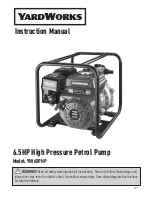
CRR-20 & CRR-40, September 1999
Refrigeration Maintenance and Service Operations
Expansion Valve Replacement
6-19
Expansion Valve Replacement
Removal
1.
Close the liquid line service valve and pump down the low
side to -35 kPa, -0.35 bar, 10 in. vacuum. Break the vacu-
um with nitrogen between 10 and 20 kPa, 0.10 and 0.20
bar, 1 and 3 psig.
2.
Remove insulating tape and unclamp feeler bulb from the
suction line in the condenser section. Note the position of
the feeler bulb on the side of the suction line.
3.
Remove insulating tape from expansion valve outlet line.
4.
Heat and unsolder the equalizer line from expansion
valve.
5.
Heat and unsolder the liquid line inlet and outlet connec-
tions to expansion valve in condenser section.
6. Remove expansion valve from unit.
Installation
1.
Clean the liquid lines and equalizer lines for soldering.
2.
Place new expansion valve in position in liquid line.
3.
Solder liquid line inlet and outlet line connections to
valve.
4.
Solder equalizer line to expansion valve.
5.
Clean the suction line to a bright polished condition.
Install the feeler bulb of new power head in the feeler bulb
clamp on the suction line. Locate bulb on the suction line
in former position. The feeler bulb must make good con-
tact with the suction line or operation will be faulty.
Cover with insulating tape.
6.
Pressurize the low side and test for leaks (see “Refrigerant
Leak Test Procedure” in this chapter).
7.
If no leaks are found, recover the leak test gas (see
“Refrigerant Recovery” in this chapter).
8.
Evacuate the low side (see “Evacuation and Cleanup of
the Refrigeration System” in this chapter).
9.
Cover expansion valve outlet line with insulating tape.
10. Open the liquid line service valve and place the unit in
operation.
11. Operate the unit and note the suction pressure and con-
tainer temperature to see that the expansion valve is prop-
erly installed and that the feeler bulb is properly located.
Heat Exchanger Replacement
Removal
1.
Close the liquid line service valve and pump down the low
side to -35 kPa, -0.35 bar, 10 in. vacuum. Break the vacu-
um with nitrogen between 10 and 20 kPa, 0.10 and 0.20
bar, 1 and 3 psig.
2.
Remove the “U” mounting clamps that hold the heat
exchanger assembly to the wall of the condenser section.
3.
Heat and unsolder liquid inlet and outlet line connections.
4.
Note position of feeler bulb on the side of the suction line.
Un-tape and remove the feeler bulb from the suction line.
5.
Heat and unsolder the suction line connections.
6.
Lift the heat exchanger assembly from the unit.
Installation
1.
Clean the tubes for soldering.
2.
Place the heat exchanger assembly in the unit and install
the mounting hardware.
3.
Solder the suction line connections.
NOTE: It is strongly recommended that dry nitro-
gen be used to purge the system during any sol-
der operations (see “Using Pressurized
Nitrogen” in this chapter).
NOTE: If pressurizing with nitrogen, front seat
the discharge valve to prevent nitrogen from
entering the refrigerant charge.
CAUTION: Any time the discharge valve is front
seated, disconnect the unit power source to pre-
vent accidental compressor start-up.
4.
Solder the liquid line connections.
5.
Pressurize the low side and check for leaks (see
“Refrigerant Leak Test Procedure” in this chapter).
6.
If no leaks are found, recover the leak test gas (see
“Refrigerant Recovery” in this chapter).
7.
Evacuate the low side (see “Evacuation and Cleanup of
the Refrigeration System” in this chapter).
8.
Clean suction line to a bright polished condition. Install
feeler bulb in the feeler bulb clamps on the suction line.
Locate bulb on the suction line in former position. The
feeler bulb must make good contact with the suction line
or operation will be faulty. Cover with insulating tape.
9.
Open the liquid line service valve and place unit in opera-
Содержание CRR-20
Страница 4: ......
















































